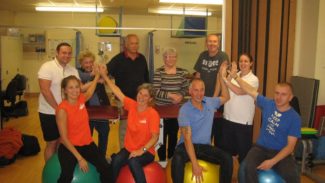
Physiotherapy
Discover the important role physiotherapy plays in managing your axial SpA
Read more
Which complementary therapies can be beneficial in axial SpA?
This information is for anyone with axial spondyloarthritis, including people with ankylosing spondylitis
Complementary therapies are designed to work alongside conventional medicines and treatments rather than to replace them.
Most complementary therapies concentrate on treating the whole person (holistic) rather than specifically treating the condition itself.
Like conventional medicine, complementary therapies cannot cure axial SpA.
Manipulative therapies are not recommended for people with axial SpA.
Acupuncture involves inserting fine needles at specific points in the skin. The needles may be stimulated manually, by heat or by a small electrical current (electroacupuncture). The needles are very fine, so having them inserted is rarely painful. You may sometimes feel a sensation of heaviness or tingling where the needles go in – this is considered a good sign.
There are two main forms of acupuncture: traditional Chinese and modern Western acupuncture:
The exact way acupuncture works remains unclear but it seems to relieve pain by diverting or changing the painful sensations that are sent to the brain from damaged tissues and by stimulating the body’s own pain-relieving hormones (endorphins and encephalins).
Some people have found that acupuncture is good at helping with flares.
The Alexander technique teaches improved posture and movement. You are taught to be more aware of the position of your body to correct poor postures and to move more efficiently. The main principles are:
If you’re thinking about trying the Alexander technique, it’s important that the teacher you choose is experienced and qualified. The Society of Teachers of the Alexander Technique (STAT) is the main organisation and has a database you can use to find a qualified teacher in your area.
Aromatherapy uses essential oils from plants to promote health and wellbeing. Essential oils can be used in many ways, including as a vapour which is inhaled, in baths. in a burner or as part of an aromatherapy massage.
It is believed that each oil has its own particular properties – some are considered invigorating, some relaxing and some are claimed to act as anti-inflammatories. Rosemary, camomile, majoram and juniper oils are all thought to be good for muscular or joint aches and pains.
Pure essential oils can be used at home but should not be applied directly to your skin. The undiluted use of essential oils on the skin can be harmful and potentially cause severe irritation.
Chiropractors provide a range of treatments which some people with axial SpA find helpful alongside treatments like medication and physiotherapy. If you decide to consult a chiropractor, do ensure you give your full medical history and alert your therapist if you have any spinal fusion. You should not have any spinal manipulation.
Chiropractic is a statutorily-regulated profession and chiropractors have a strict code of practice. More information is available from the General Chiropractic Council (GCC) and The Royal College of Chiropractors (RCC).
A lot of people with axial SpA do find massage beneficial, especially in helping to manage pain or as a means of relaxation.
On its own, massage is not going to improve your flexibility, but it may help to reduce pain and discomfort so that you are then more likely to feel like stretching out after the massage and working on maintaining good posture. The effects of massage tend not to be very long lasting.
There are many forms of massage, but the two most common forms are Swedish and deep tissue massage:
Swedish massage uses 5 types of massage strokes, with the most frequently used one known as “effleurage” which is a sliding or gliding stroke in long sweeping movements, and is more superficial
Deep tissue massage uses similar techniques to the Swedish massage but is slower and the pressure used is deeper and often applied across the grain of the muscle and concentrated on areas of pain or tension
Both types of massage can help people with axial SpA. Be aware that if your back is tender to the touch or your ribs are painful, you may find massage painful.
Sometimes an elbow or forearm is used to apply pressure and it’s worth highlighting that you don’t want this before the massage begins.
Mindfulness is a mind-body approach to well-being that can help you change the way you think about experiences. The idea is to be in the moment, exactly as you are, without judging or trying to change anything.
NASS ran two Facebook Live sessions on Mindfulness with Sophie Matthew. You can find them on our My AS, My Life page.
Osteopaths provide a range of treatments which some people with axial SpA find helpful alongside treatments like medication and physiotherapy. If you decide to consult an osteopath, do ensure you give your full medical history and alert your therapist if you have any spinal fusion. If you do have spinal fusion then you should not have any spinal manipulation.
Osteopaths are a statutory regulated profession and have a strict code of practice. The governing body is the General Osteopathic Council www.osteopathy.org.uk. You can search the register to ensure a practitioner is registered with them.
Transcutaneous Electrical Nerve Stimulation (TENS) machines work by delivering small electrical pulses to the body via electrodes placed on the skin.
TENS machines are thought to affect the way pain signals are sent to the brain. Pain signals reach the brain via nerves in the spinal cord. If pain signals can be blocked then the brain will receive fewer signals from the source of the pain and less pain may be felt.
TENS machines are thought to act by stimulating the body to make its own pain-easing chemicals called endorphins. These act a bit like morphine to block pain signals.

Discover the important role physiotherapy plays in managing your axial SpA
Read more
Discover axial SpA services in your area
Read more